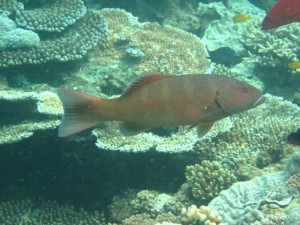NERP TE Project 8.1 - Monitoring the ecological effects of GBR zoning plan on mid and outer shelf reefs (AIMS)
Project summary
The rezoning of the Great Barrier Reef Marine Park (GBRMP) in 2004 increased the number and extent of 'no-take' areas within the Park. This project surveys pairs of reefs, one in a 'no-take' or green zone and the other a similar reef where fishing is allowed (blue zone), in five regions of the GBRMP. Green and blue zones will be surveyed for the abundance and size of fishery species, particularly coral trout, as well as wider effects on coral reef communities. Indirect or flow-on effects of protection from fishing on reef ecology may take one to two decades to develop, so surveys over the course of the NERP will track the longer-term effects of zoning as they develop.
Why this research is needed
No-take zones are the primary management tool for protecting marine biodiversity. Given that the GBRMP has one of the largest networks of no-take zones in the world, it is an appropriate place to assess the effectiveness of no-take zones for biodiversity conservation. This research will inform park managers and users on the effectiveness of the rezoning in conserving the marine biodiversity of the GBR, and the findings will be of interest to marine park managers and conservationists around Australia and across the world.
Research-user focus
This project will provide up-to-date information on the effectiveness of the rezoning and the current status of the GBR to the Great Barrier Reef Marine Park Authority (GBRMPA) and the Australian community. The outputs of the project will also contribute to the 2014 Great Barrier Reef Outlook Report produced by the GBRMPA and the Department of Sustainability, Environment, Water, Population and Communities.
Outcomes
This project will:
- Provide updates on trends in selected fish species targeted by fishers on fished and no-take reefs.
- Produce scientific publications on the effectiveness of a large network of marine protected areas.
- Produce scientific publications on the dynamics of coral and fish communities in relation to management and environmental drivers.
Reports, Publications and News
For more information see Project 8.1 'Monitoring the ecological effects of the Great Barrier Reef zoning plan on mid and outer shelf reefs' on the NERP Tropical Ecosystems Hub site.
Images
Datasets
70 selected reefs throughout the Great Barrier Reef (GBR) are sampled in the AIMS Long-term Monitoring Project (LTMP). Underwater visual census is used to survey reef fishes on fixed transects (3 sites per reef, 5 x 50 m transects per site). The abundance and length of all diurnally active, non-cryptic fishes are recorded. A full list of species observed each year can be obtained on request.
The overarching goal of LTMP fish surveys are to detect changes in reef fish communities over time at a regional scale, but also to examine the effectiveness of Marine Protected Areas.
This dataset consists of summaries of benthic, fish and manta tow surveys conducted in the Capricorn-Bunker Region of the Great Barrier Reef in October 2015. It consists of three tables:

The rezoning of the Great Barrier Reef Marine Park (GBRMP) in 2004 increased the number and extent of ‘no-take’ areas within the Park. This project surveys pairs of reefs, one in a ‘no-take’ or green zone and the other a similar reef where fishing is allowed (blue zone), in five regions of the GBRMP. Green and blue zones will be surveyed for the abundance and size of fishery species, particularly coral trout, as well as wider effects on coral reef communities. The results of reef surveys will be used to:
Benthic organisms were surveyed annually on fixed sites in one habitat on each of 47 selected core survey reefs from 1993 to 2005 in 6 regions throughout the Great Barrier Reef (GBR). Surveys were undertaken at 3 sites per reef, with 5x50m transects surveyed per site.In 2004 a new zoning plan was implemented in the Great Barrier reef Marine Park and in 2006 the pattern of surveys was changed. The original set of reefs (47) are surveyed in odd years (e.g. 2007) and a different set (56 reefs) are surveyed in even years.
64 'key' reefs in 11 sectors of the Great Barrier Reef (Cape Grenville, Princess Charlotte Bay, Cooktown/Lizard Island, Cairns, Innisfail, Townsville, Cape Upstart, Whitsunday, Pompey Complex, Swain and Capricorn Bunker) are annually surveyed for crown-of-thorns starfish using the manta tow technique. An additional 117 reefs from the sectors (excluding the Whitsunday, Swain and Capricorn-Bunker sectors) are scheduled for survey every third year ('cycle' reefs).








